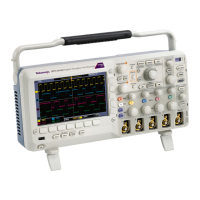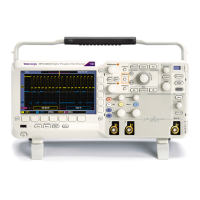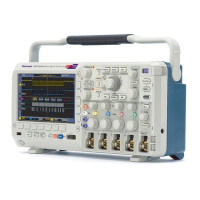
Do you have a question about the Tektronix DPO2024B and is the answer not in the manual?
| Brand | Tektronix |
|---|---|
| Model | DPO2024B |
| Category | Test Equipment |
| Language | English |
Highlights the main capabilities and functionalities of the MSO2000B and DPO2000B series oscilloscopes.
Explains the icons, symbols, and terminology used throughout the user manual for clarity.
Guides on unpacking the oscilloscope and checking standard accessories for initial setup.
Details environmental and physical specifications such as voltage, temperature, humidity, and dimensions.
Explains how to connect different types of probes, including TekVPI and digital probes.
Provides instructions on how to physically secure the oscilloscope to prevent theft or movement.
Describes the procedure for safely powering on the oscilloscope, including grounding.
Outlines a quick check to verify the oscilloscope is operating correctly after initial setup.
Details how to compensate passive voltage probes for accurate measurements.
Guides users on how to install optional application modules to extend oscilloscope functionality.
Explains how to change the language settings and front-panel overlay.
Provides steps to set the oscilloscope's internal clock to the correct date and time.
Describes how to perform signal path compensation for DC accuracy and performance.
Details the process of updating the oscilloscope's firmware via a USB flash drive.
Explains methods for connecting the oscilloscope to a PC for data transfer and control.
Provides an overview of the front panel buttons, knobs, and menu system for operation.
Explains the various readouts and icons visible on the oscilloscope screen during operation.
Identifies and describes the purpose of connectors located on the front panel.
Details the side-panel connector, typically for probe power supply.
Identifies and describes the purpose of connectors located on the rear panel.
Guides on configuring analog channels for signal acquisition using front-panel controls.
Explains how to add descriptive labels to channels and buses on the display.
Describes how to restore the oscilloscope to its factory default settings.
Details how to use the Autoset function for automatic waveform display setup.
Explains the fundamental concepts behind signal acquisition and waveform record creation.
Guides on adjusting acquisition parameters like mode, record length, and delay time.
Describes Roll mode for viewing low-frequency signals as a strip chart.
Explains how to configure and trigger on serial and parallel buses.
Details how to set up and acquire signals using the digital channels on MSO2000B models.
Explains how to use FilterVu to reduce noise while preserving signal details.
Introduces trigger events and how they establish a time reference for waveform records.
Explains different trigger modes like Normal and Auto, and their behavior without trigger events.
Describes how slope and level controls determine trigger point detection on signal edges.
Guides on selecting various trigger types such as Edge, Pulse Width, Logic, and Bus.
Explains how to set up triggers for various serial and parallel bus protocols.
Details how to start and stop waveform acquisitions using Run/Stop or Single buttons.
Covers adjusting display styles like persistence for waveform visualization.
Explains how to set input parameters like coupling, invert, bandwidth, and probe setup.
Details how to adjust horizontal and vertical scale and position for waveform viewing.
Guides on arranging, scaling, and grouping digital channels for display.
Explains how digital channel data is displayed, including logic levels and transitions.
Describes how to add custom text annotations to the oscilloscope screen.
Guides on how to perform and add automatic measurements to waveforms.
Lists and describes available time and amplitude automatic measurements.
Explains how to customize measurements using gating, snapshots, or high/low levels.
Details how to use on-screen cursors for manual measurements on waveforms.
Guides on creating and using math waveforms for advanced signal analysis.
Explains how to use the Fast Fourier Transform (FFT) for frequency domain analysis.
Describes how to create, store, and use reference waveforms for comparison.
Details how to capture and save the oscilloscope screen as an image file.
Guides on saving and recalling waveform data to internal memory or external storage.
Explains how to save and recall instrument settings and configurations.
Describes how to configure a single button for quick save operations.
Explains how to save setup, screen image, and waveform files simultaneously.
Details the procedure for printing oscilloscope screen images to a PictBridge compatible printer.











